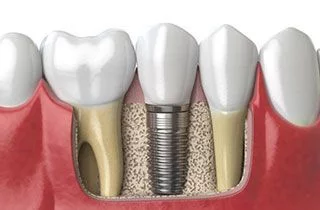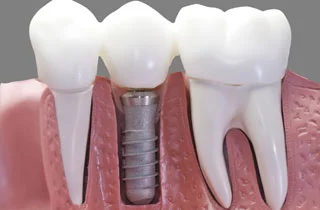Although the success rate of the insertion of implants is really high – well above 90% –certain problems may still occur. Even this modern tooth replacement solution can have defects sometimes. The implant or the screw holding the superstructure may become loose, and the later can even break. Although it occurs rarely, artificial roots can break as well.
>Whatever problem we have to face with our dentures, there is absolutely no need for panic. Thanks to modern dentistry, dental implant repair can save the implants and the tooth replacement built on them in most cases.
This article offers an overview of the following topics:
- What are the risks of implantation?
- The rejection of implants and its signs
- Breakage of the implant
- Defects of the superstructure
- Causes for a cracked or broken implant
- Suggestions to avoid problems
What are the risks of implantation?
When the dentist inserts the implant in the jaw bone, they fix it tightly and permanently. This way it can hold the tooth replacement built on it and bear the external forces affecting it while chewing. In some cases it may still loosen, start to move or even fall out. This rare phenomenon may be a result of the following:
- insufficient extent of ossification, therefore the implant’s imperfect integration into the jaw bone
- inflammation of the soft and hard tissues surrounding the implant
- insufficient amount of bone material
- shifting effects resulting from early overload, loosening of connection to the bone
- inadequate primary stability during implantation into the jaw bone
- imprecise surgical intervention
- smoking
- neglecting necessary oral hygiene (even more strict in this case), non-compliance of instructions
Whatever reason from the above is responsible for the loosening of the implant, once the artificial roots have loosened, there is no dental implant repair for them. A wobbling implant has little or no connection to the jaw bone. In this case the only solution is the insertion of a new implant. Your dentist must remove the moving, loose artificial root as soon as possible. If the condition of the bone, the gum and the oral cavity make it possible, you must get a new implant to replace the loosened one. Before the insertion of a new implant, jaw bone restoration or even a sinus lift may be necessary.
The rejection of implants and its signs
Successful implantation occurs when the implant root integrates securely into the jawbone and can support the tooth under normal load. The healing process should proceed smoothly, with only minor bleeding, pain, or swelling, and without complications.
However, there are certain indicators of unsuccessful implantation. This section highlights these warning signs.
Returning gingivitis
The main reason for unsuccessful implantation is returning gingivitis around the implantation.
The outer symptoms of the illness are the intense red color and bleeding of the mucosa, swollen gum, temperature, and low fever.
Regular pain
Severe or regularly returning pain can also be the sign of the implantation’s rejection.
The mobility of dentures
The looseness or mobility of dentures often indicates underlying inflammatory processes. After implantation, the treated area should be loaded carefully and gradually. If you have followed all post-operative instructions but still feel movement in your implant, it is important to inform your dentist promptly. They will recommend the necessary examinations to address the issue.
Other symptoms
Rare symptoms include discharge when pressing on the area, pus formation, sinus infections, or mucositis, particularly in patients with cancer.
If you notice any suspicious symptoms, consult with your dentist promptly.
In the case of immediate action, the process can be reversible.
Defects of the superstructure
There is very little possibility that the artificial root screwed into the jaw bone gets broken. (The superstructure and the screws holding it are more likely to get broken.) With today’s more developed implants this problem almost never occurs.
Still, certain issues may arise during manufacturing, the insertion or the usage. Implants usually get cracked or broken due to the following reasons:
- manufacturing or material defect
- imperfect integration into teeth structure, malpositioned implant
- physical or biomechanical overload

Physical overload might be a result of external forces affecting the jaw bone and the oral cavity (e.g.: accident). Biomechanical overload can be, for example, continuous teeth grinding (bruxism).
Whatever the cause of its breakage may be, in these cases dental implant repair means replacing the implant.
However, the insertion of new artificial roots actually is a new implantation. Therefore when calculating the time necessary for complete recovery, you must take into account the ossification period taking three to six months.
Breakage of the implant
Defects of superstructures screwed into implants are easier to deal with. Dental implant repair can usually solve the problem, without having to worry about longer healing time.
The screw holding the implant superstructure may loosen. In this case, the patient feels that the tooth

replacement is unstable, wobbling. If no break or crack has occurred, the issue can be solved by tightening the fixation screw.
The problem is more serious, however, when it is the fixation screw of the superstructure to crack or break. Should this be the case, dental implant repair means removing the screw and replacing it with a new one, or it must be repaired on the spot.
If the fixation screw gets broken, the issue is very problematic because, in the first place, certain damaged parts may be stuck in the implant, and their removal becomes more difficult.
Causes for a cracked or broken implant
In rare cases, the screw securing the superstructure may crack or break after implantation. While this can occasionally be due to material defects, it is more commonly caused by the following issues:
- The tooth replacement does not fit in the teeth perfectly. During chewing and biting extensive external forces weaken the superstructure and the fixation screw.
- The surgeon that carries out the implantation does not adjust the axis of the artificial root perfectly.
- Negligence and carelessness of the patient. Instead of seeking medical care in case of a loosened implant, some people wait until it is cracked or broken.
Can you remove a dental implant and replace it?
Yes, dental implant replacement is possible. The process of implant replacement:
Removal of the old implant: A damaged or loose implant is removed through a minor surgical procedure. Healing phase: The jawbone must heal after the implant is removed before a new one can be inserted. Insertion of the new implant: After the healing phase, the new implant is inserted and fuses with the jawbone. Crown or bridge: Once the implant is firmly attached to the bone, the final dental crown or bridge is attached.
How painful is the removal of a dental implant?
Dental implant removal is usually done under local anaesthesia, so you should not feel any pain during the procedure. However, mild pain or pressure may occur after the treatment, which can be easily treated with painkillers.
Suggestions to avoid the need for dental implant repair
There are some basic rules that you should follow so that you can use your implants with great satisfaction:
- You should have the implantation carried out by a dental expert who has significant and verifiable experience in this field. It is important that this expert is assisted by a complex team.
- Follow the instructions of your doctor during the first phase of implantation carefully.
 Avoid overloading the implant during the ossification period! Start using your implant gradually, according to your doctor’s instructions, even when osseointegration is complete.
Avoid overloading the implant during the ossification period! Start using your implant gradually, according to your doctor’s instructions, even when osseointegration is complete.
It is vital to prevent inflammation around the implant. Thus, the patient must clean the area of the artificial root and the implants even more thoroughly than usual. Failure to do so may result in periimplantitis, which is a rapidly progressive inflammation around the artificial root. This inflammation may cause them to loosen or even fall out. Besides daily cleaning, professional dental cleaning of the dentures is necessary from time to time.
It is also important that you visit your dentist immediately if you experience even the slightest change with your implant. Unpleasant breath odour or taste, and latent pain or tension that is difficult to identify are all causes for concern, and should be examined. These symptoms all indicate that a negative process has been taking place around the implants. If you take the initial symptoms seriously and seek medical help, you can prevent the occurrence of more serious problems. What about dental implants in diabetes?

